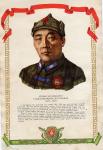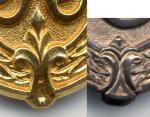-
Posts
14,343 -
Joined
-
Last visited
-
Days Won
25
Content Type
Profiles
Forums
Blogs
Gallery
Events
Store
Everything posted by Ed_Haynes
-
Until the 1960s, this sort of "type collecting" was common among British collectors. Groups were routinely broken up and the only desire was to get desirable medal and clasp combinations, with no regard at all for the naming (unless it was named to a non-European and then the medals tended to be denamed as unnamed medals were more highly valued than a medal, say, to an Indian). It was all rather like stamp collecting, filling "holes" in the stamp album. As Payne was one of the fathers of British medal collecting, he was also a progenitor of this approach. Clasps couuld be swapped about to make a scarce combination (as they still are today). Look at the number of dealers selling loose clasps. Where did those come from? Whose medals got stripped and why?? While the collecting of British medals (defined broadly) has mostly evolved beyond this today, other phaleristic fields retain this view.
-
Yes, this looks like one of that vast number of merit certificates for various forms of achievement. This one for something to do with herding, but not at the level of achievement to receive the badge.
-

Soviet Details "Order of Glory"
Ed_Haynes replied to westfale's topic in Russia: Soviet Orders, Medals & Decorations
You can always get The Researcher to do the work, though his life has been busy of late, and research slows. PM sent. -

Soviet Powerful Hero of Russia Citation
Ed_Haynes replied to slava1stclass's topic in Russia: Soviet Orders, Medals & Decorations
Hindi. You mean not everyone speaks Hindi? It has some 900 million speakers, while Russian has but 260 million. -

Mongolia Early General Magsarjav
Ed_Haynes replied to new world's topic in People's Republic Mongolia
-

Soviet Powerful Hero of Russia Citation
Ed_Haynes replied to slava1stclass's topic in Russia: Soviet Orders, Medals & Decorations
Maaf kijiya, Slava. Is ka maloom hume nahin aate hai. -
Eewwwww. I don't much like the sound of this. You have to wonder what this evil concoction will look like and what it will have done to the medal after 15-20 years. We need to be careful about acting too aggressivel;y on the mistaken idea that we "own" these things and can, therefore, do to them whatever we wish.
-

Mongolia Order of Civil Valour & Red Banner of Labour
Ed_Haynes replied to Vatjan's topic in People's Republic Mongolia
Investment. Investment? That is something I don't even remotely think about. -

Mongolia Order of Civil Valour & Red Banner of Labour
Ed_Haynes replied to Vatjan's topic in People's Republic Mongolia
Really? I have paid that much for some items (and oh how it hirt), and would not spend anywhere near that in other areas (except my core focus). I find it amazing and scandalous what some people pay for German (especially 3rd Reich) stuff. Maybe it depends on the perspective, and there isn't one common view, William. You seem to assume there is?! -
Thanks for this one. It is always interesting to see those bizarre unofficial French clasps.
-

Chivalric Orders - Medals of the Order of Malta
Ed_Haynes replied to Ralph A's topic in Southern European & Balkan States
Interesting theoretical question as to whether SMOM stuff should be treated as "Malta" or "Global". I'd vote for the second. -
Yes. So sad. And, as I recall, there are couple more similar ones lying with the same person that will probably come to market soon.
-

Soviet Medal House
Ed_Haynes replied to Bryan's topic in Russia: Soviet Orders, Medals & Decorations
A fascinatimng and important perspective, thanks! -

Soviet Soviet & Eastern Block Quiz
Ed_Haynes replied to Christophe's topic in Russia: Soviet: Other Militaria
Do I get the sense we are very VERY puizzled here . . . ?? These are "Soviet & Eastern Block" (however defined?)? -

Mongolia Order of the Red Banner of Industrialization MPR
Ed_Haynes replied to Vatjan's topic in People's Republic Mongolia
Oh . . . No matter how good the image, nothing can ever prepare you for these, JC! And a low enough number that research may be interesting when The Day comes. -
The originals of these, especially if made "in-country" (as these seem to be) are uncommon and desirable items.
-

Dave Suter's bunker
Ed_Haynes replied to Dave Suter's topic in Germany: Third Reich: Uniforms, Headwear, Insignia & Equipment
Thanks for these Dave. While far FAR outside my "turf", I always enjoy seeing and learning new things. -

Upham's VC and bar
Ed_Haynes replied to jonightflyer's topic in Great Britain: Orders, Gallantry, Campaign Medals
And not with Lord Ashcan? I do find it odd that the IWM bought something for display in NZ. When they can't maintain and expand their own collections! -

Upham's VC and bar
Ed_Haynes replied to jonightflyer's topic in Great Britain: Orders, Gallantry, Campaign Medals
- New Zealand War Service Medal - Coronation Medal 1953 - Jubilee Medal 1977 - New Zealand Commemoration Medal 1990 -

Kaisar-i-Hind Medal
Ed_Haynes replied to Ed_Haynes's topic in Great Britain: Orders, Gallantry, Campaign Medals
By request, the botton designs on a GV 2nd variety and a GVI Kaisar-i-Hind. See why I use this device as my quick-reference characteristic? -

Kaisar-i-Hind Medal
Ed_Haynes replied to Ed_Haynes's topic in Great Britain: Orders, Gallantry, Campaign Medals
As India developed its own system of honours, the Kaisar-i-Hind medal remained an important ideal. The committee on awards proposed an order or a medal in three classes for humanitarian services (roughly, a continuation of the Kaisar-i-Hind medal). This medal was to have strict annually limited awards of twenty for the first class, forty for the second class, and eighty for the third class. <Draft Report of the Committee on Honours and Awards in India, n.d., Office of the Private Secretary to the Viceroy (NAI), 25-H/48, p. 48 ff; Memo of Third Committee Meeting, 9 March 1948, Office of the Private Secretary to the Viceroy (NAI), 25-H/48, p. 48.> This suggestion eventually evolved into the Padma Vibhushan, Padma Bhushan, and Padma Sri. To represent the history of the award, one representative group. To 100032 Clerk JM Biswas IWT, RE. Kaisar-i-Hind in bronze, George VI. -

Kaisar-i-Hind Medal
Ed_Haynes replied to Ed_Haynes's topic in Great Britain: Orders, Gallantry, Campaign Medals
As independence approached, changes in the honors system mirrored the impending reshaping of the political landscape. In January 1947, it had been decided to discontinue all awards of honors or titles to Indians, but an exception was made for military awards, in part to deal with the ongoing necessity for late awards for the recently concluded war. This meant that all titles (both the main series ? Rai Bahadurs and so on ? and special titles ? the Shams-ul-Ulama and Vaidyaratna sequences) would be terminated, as would the Indian orders. <Background note for discussions with Jawaharlal Nehru and with Liaqat Ali Khan, ca. 6 November 1946, R/3/1/267 (IOR); note by Private Secretary to the Governor General, undated (about January 1948?), Office of the Private Secretary to the Viceroy (NAI), 25-H/48, p. 3.> The press communiqu? announcing this decision specified gallantry awards, the Order of British India, possible civilian awards for gallantry, police and fire services medals, and Kaisar-i-Hind awards for humanitarian services. All ?Indian titles? had been specifically terminated, though the place of the ex officio titles that accompanied the classes of the Order of British Indian were left vague. Tellingly, though, the ban on awards applied only to ?British India?; presumably, awards in ?Indian India?, in the ?Princely States?, would (or could) continue. <Office of the Private Secretary to the Viceroy (NAI), 37(19)-H/47. This communiqu? is given in full in Appendix 2. See also letter, Prime Minister to Viceroy, 28 August 1947, Office of the Private Secretary to the Viceroy (NAI), 364-H/46.> Efforts to retain the Kaisar-i-Hind medal, with a new name (the inelegant suggestions included the clumsily indigenized ?Badshah-i-Hind?) with redesign at least as far as the imperial cipher was concerned, proved untimately unsuccessful. <Committee on the Grant of Honours, Decorations and Medals, 514th Report, ?Kaisar-i-Hind Medal,? 28 April 1948, DO 35/3303 (PRO); letter, Secretary of State for India to the U.K. High Commissioner New Delhi, 3 February 1948, Office of the Private Secretary to the Viceroy (NAI), 18(3)-H/47.> The whole system of awards, honed and refined in a conscious process since the displacement of the East India Company in 1859, began to be wound up throughout early August 1947, as final awards were gazetted; the review of these awards provides a useful parting snapshot of the system as it stood at the closing moment of the British Empire in India. It is perhaps a suitable irony that the closing set of honors from the Emperor of India was the Kaisar-i-Hind medal, all other awards having been terminated. ? Kaisar-i-Hind, gold ? Miss Jean Murray Orkney, W.M.S., M.B., Ch.B. (St. Andrews), D.P.H. (Manchester), Chief Medical Officer, Women?s Medical Service (actually a bar to her earlier award of the gold medal) <Office of the Private Secretary to the Viceroy (NAI), 4-H/1948.> ? Kaisar-i-Hind, silver ? Millicent, Lady Tymms (wife of Sir Fredick Tymms, K.C.I.E., M.C., Director-General, Civil Aviation, Government of India) <Office of the Private Secretary to the Viceroy (NAI), 4-H/1948.> ? Kaisar-i-Hind, bronze ? Gajadhar Upadhya, Esq., Chief Regimental Religious Teacher, 1st (K.G.V.?s Own) G.R. [Gurkha Rifles] <Office of the Private Secretary to the Viceroy (NAI), 4-H/1948.> One final, postmortem, Kaisar-i-Hind in gold hounous list would be publsihed in the London Gazette: 30 December 1947 http://www.gazettes-online.co.uk/archiveVi...;selHonourType= So general was this sea change in the world of imperial honors that it now became impossible for Indian and Pakistani employees of the British to be rewarded for their services. In 1948, awards of the M.B.E. to an Indian accountant in the British embassy in Baghdad and of the M.B.E. and B.E.M. to two Pakistani medical personnel in the British embassy in Kabul had to be declined due to concerns over the complexities of dominion relations involved. <See correspondence in L/P&S/15/158 (IOR).> Visually separating George V and George VI badges is a major problem. The attached image may (?) help: 1- George V, firsr variety (gold) 2- George V, second variety (gold) 3- George VI (silver) Note especially the designs of the surrounding oval, especially at the botton. (That is the clue I use, the sharp centre-bottom device for George V as opposed to the softer design for George VI.) The cyphers are different, though you may have to stare for a while to see it. -

Kaisar-i-Hind Medal
Ed_Haynes replied to Ed_Haynes's topic in Great Britain: Orders, Gallantry, Campaign Medals
-

Kaisar-i-Hind Medal
Ed_Haynes replied to Ed_Haynes's topic in Great Britain: Orders, Gallantry, Campaign Medals
Before moving on the the final awards of the Edward VIII and George VI era, two awards deserve special attention. The awards of Kaisar-i-Hind medal in gold to Khan Bahadur Mogul Baz Khan, I.O.M., I.D.S.M., and Khan Bahadur Kuli Khan were completely unprecendented and -- judged by the standards for the medal -- totally inappropriate. London Gazette 25 May 1923: http://www.gazettes-online.co.uk/archiveVi...p;selHonourType And, therefore, they are quite fascinating!






